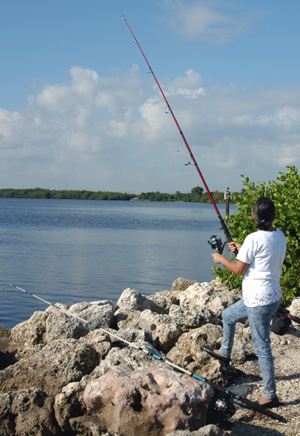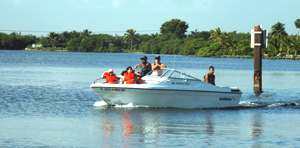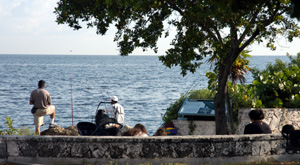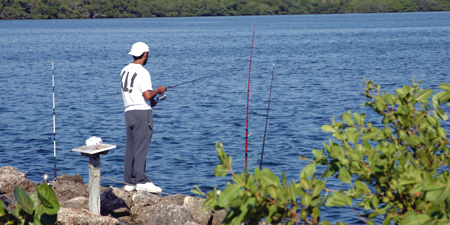
Diverse Biscayne fishing attracts anglers
HOMESTEAD, Fla.— Housing over 200 species of fish throughout its 172,924 gross acres, Biscayne National Park is widely known as a great place to fish. It offers something for the serious or casual, the newcomer or the veteran, and the adventurous or the relaxed fisherman.
 |
| A woman casts from the Convoy Point jetty at Biscayne National Park (Photos by Bruce Garrison).. |
Biscayne appeals to fishermen so much because of the high quality of the environment and the numerous types of fish to be found.
The water is some of the clearest in Florida.
“It’s like looking through a pane of glass” said local fisherman Matt Armstrong, 19, of Miami. “The only other places I’ve seen water this clear is in the Keys and Mexico and this is a little bit closer.”
The park houses the third-longest tract of coral reef in the world sheltering a variety of colorful and distinctive fish.
Among those to be found are the rock beauty, the queen angelfish, the parrotfish, the moray eel, stingrays, squids and five species of sea turtle.
Though most of the glitzy and glamorous fish are not what attract the attention of fishermen.
That is done by the larger and tastier fish among these are Snook, Bonefish, Tarpon, Snapper, Grouper, and Hogfish, Grunt and Barracuda.
“Unless you go down to the Keys, this is the best fishing you’ll find,” claimed Drew Cook, 19, a former resident of Islamorada who currently resides in Melbourne, Fla.
Almost as great an appeal as the desirable fish to be found are the different ways to try and catch them.
 |
| A group of anglers heads into the bay. |
Shark fishing involves some seriously heavy line and tackle, fishing in the mangroves for fish like the elusive Snook will challenge your ability to cast and jib, go after the bigger fish like Tarpon that put up quite a fight, or even try your hand at spearing fishing with nothing but a snorkel, goggles, spear and your wits.
Spear fishing is in itself something that can be done at few other places than Biscayne National Park.
It requires that the fish be close to the surface, preferably living on patch reefs. Then you dive down and attempt to shoot the fish, Biscayne has the fortune of housing many patch reefs in shallow enough water to make this feasible.
To some, the most appealing thing about fishing in Biscayne National Park, however, is the opportunity it provides you to get away from it all.
“One of the main reasons I come here is it’s so close to the city yet secluded,” proclaimed Armstrong.
“When you’re at the park, you would never think that a city the size of Miami is only a couple miles away.”
In order to fish at Biscayne National Park fishing licenses are required, unless you meet one of the exemptions. Among the exemptions are all children under 16, residents over the age of 65, those fishing from land or any structure fixed to land. A complete list of all exemptions can be found at Recreational Saltwater Fishing License(s) Requirements (http://www.marinefisheries.org).
According to a Park Ranger at Biscayne National Park recreational licenses and permits for residents and nonresidents are available at county tax collectors’ offices.
In addition, they are available from subagents, such as sporting goods stores or other retailers selling hunting or fishing equipment. The price of the license varies depending on the length of the license and what type of fishing you are planning on doing. There is a resident discount.
 |
| Anglers cast their lines from the boarwalk. |
Recently there has been troubling news about the park. A 2001 study of the fishing populations are down in the park.
The study looked at over 25 years of fishery data and found that 77 percent of 35 popular species – grouper, snapper, grunt and barracuda – are over-fished, often dating back to the 1970s.
In January 2004, the National Parks Conservation Association, named Biscayne Bay to its list of the 10 most endangered parks in the United States. Biscayne was named to the list due to over-fishing and water pollution.
The park is considering placing restrictions on visitors of the park, said Todd Kellison, a spokesman for Biscayne National Park. In November 2003, proposals for those restrictions had been released for public discussion and consideration.
They included requiring special permits to fish in certain areas, banning gas boats in others and creating 500-foot no-entry rings around sensitive unspoiled islands. At the present date, none of these restrictions had been put in place.
According to Kellison, a list of the reforms that the park hopes to enact will be completed by the end of this year, some time during 2005 p;ark officials hope to have the reforms approved and put into place.
If fish populations continue to decline who knows what dire consequences it may bring about. The hope is that all involved will do whatever is necessary to preserve Biscayne National Park for future generations and ensure that it remains a national treasure.
 |
An angler watches four lines at one time off the jetty at Biscayne National Park. |

Comments are Closed